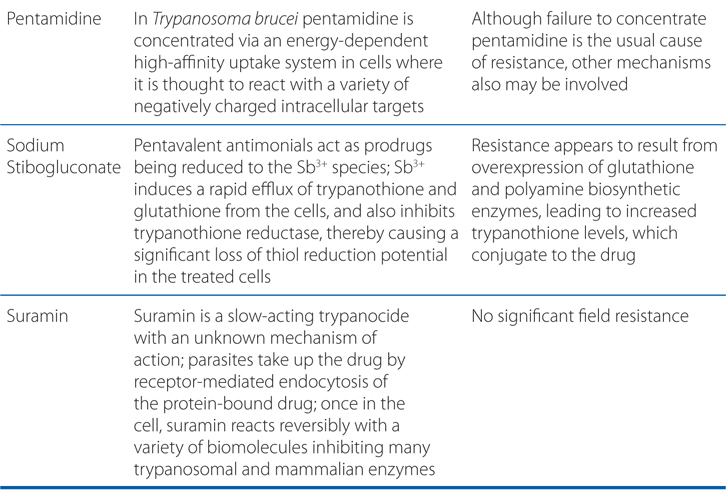36
Chemotherapy of Protozoal Infections: Amebiasis, Giardiasis, Trichomoniasis, Trypanosomiasis, Leishmaniasis, and Other Protozoal Infections
This chapter will be most useful after having a basic understanding of the material in Chapter 50, Chemotherapy of Protozoal Infections in Goodman & Gilman’s The Pharmacological Basis of Therapeutics, 12th Edition. In addition to the material presented here, the 12th Edition contains:
• A detailed discussion of protozoal infections, including amebiasis, giardiasis, toxoplasmosis, trichomoniasis, cryptosporidiosis, trypanosomiasis, leishmaniasis, babesiosis, balantidiasis, Isospora belli, and microsporidia
LEARNING OBJECTIVES
 Understand the most common protozoal infections, the clinical symptoms, and the mainstays of therapy.
Understand the most common protozoal infections, the clinical symptoms, and the mainstays of therapy.
 Describe the mechanisms of action of antiprotozoal drugs.
Describe the mechanisms of action of antiprotozoal drugs.
 Understand the treatment of giardiasis, amebiasis, and cryptosporidiosis.
Understand the treatment of giardiasis, amebiasis, and cryptosporidiosis.
 Identify the therapeutic uses of antiprotozoal drugs.
Identify the therapeutic uses of antiprotozoal drugs.
 Describe the toxicities and precautions to the use of antiprotozoal drugs.
Describe the toxicities and precautions to the use of antiprotozoal drugs.
DRUGS INCLUDED IN THIS CHAPTER
Amphotericin B (see Chapter 43)
Eflornithine (ORNIDYL)
Fumagillin (FUMIDIL)
8-Hydroxyquinolines (iodoquinol; YODOXIN)
Melarsoprol
Metronidazole (FLAGYL)
Miltefosine (IMPAVIDO)
Nitazoxanide (ALINA)
Nifurtimox (LAMPIT)
Benznidazole (ROCHAGAN)
Paromomycin
Pentamidine
Sodium stibogluconate
Suramin
PROTOZOAL INFECTIONS DISCUSSED IN THIS CHAPTER
Amebiasis
Giardiasis
Cryptosporidiosis
MECHANISMS OF ACTION AND RESISTANCE OF ANTI-PROTOZOAL DRUGS


A 35-year-old woman comes into your office complaining of diarrhea and abdominal pain for the past 3 days. She has recently returned from a white-water rafting trip. On the trip she fell out of the boat and although she had a life preserver on, she believes that she swallowed considerable amounts of river water.
a. You suspect giardiasis and want to begin treatment after obtaining appropriate specimens. What is giardiasis?
Giardiasis is caused by the protozoan Giardia intestinalis, is prevalent worldwide, and is the most common intestinal protozoal infection in the United States. Giardia is a zoonosis and cysts shed in the feces of animals and humans can contaminate recreational and drinking water supplies. Infection with Giardia results in an asymptomatic carrier state, acute self-limited diarrhea, or chronic diarrhea.
b. How is the diagnosis of giardiasis made?
The diagnosis of giardiasis is made by identification of cysts or trophozoites in fecal specimens or of trophozoites in duodenal contents.
c. After instructing your patient in how to collect fecal specimens, what is the most appropriate therapy to limit the acute diarrhea, to prevent the development of chronic diarrhea, and to prevent the development of a “carrier state”?
Chemotherapy with a 5-day course of metronidazole or a single dose of tinidazole is usually successful. Paromomycin has been used to treat pregnant women to avoid any possible mutagenic effects of the other drugs.
d. What are the potential side effects of metronidazole therapy which this patient should be informed about?
The most common side effects of metronidazole are headache, nausea, dry mouth, vomiting, and diarrhea, and are rarely severe enough to discontinue therapy. More severe neuropathies may include dizziness, vertigo, and rarely encephalopathy, seizures, incoordination, ataxia, and numbness or paresthesias of the extremities; these neuropathies warrant discontinuation of metronidazole.
Metronidazole has a well-documented disulfiram-like effect (see Chapter 9) and patients should be warned not to drink alcoholic beverages during or within 3 days of therapy.
COMMON ROUTES OF TOXOPLASMOSIS INFECTION IN HUMANS
• Ingestion of undercooked meat containing cysts
• Ingestion of vegetables contaminated with soil containing cysts
• Direct oral contact with feces of cats shedding cysts
• Transplacental fetal infection with tachyzoites from acutely infected mothers
Stay updated, free articles. Join our Telegram channel

Full access? Get Clinical Tree



